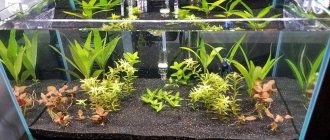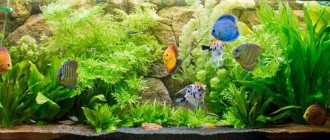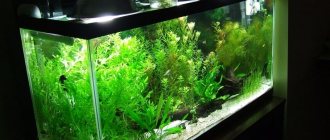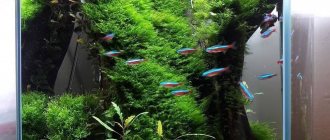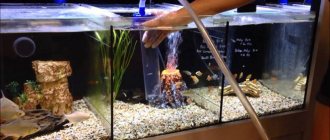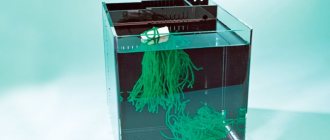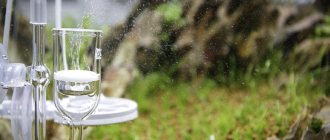Quickly navigate to the article
- 1 Why is it needed?
- 2 Requirements
- 3 Varieties
- 4 Purchased nutrient substrates and substrates
- 5 How to make it yourself
- 6 Laying
- 7 Biological role 7.1 Other interesting articles
Nutrient soil is necessary for the life of aquarium plants. Useful substrates are divided into types, contain various components, you can make it yourself or purchase a ready-made soil mixture of commercial origin.
Nutrient soil for aquarium plants
In some cases, it is not at all necessary that the aquarium soil be nutritious. Sometimes in aquascape it plays the role of a decorative material to create an appropriate landscape. But if there are living soil plants in the container, then you cannot do without fertilizing the soil.
Neutral nutrient soil
Many aquarium ornamental plants take nutrients directly from the aquatic environment. To a greater extent, floating vegetation has this quality, and the soil in such an aquarium can be neutral, that is, not containing any nutrients. Indeed, why do you need fertilizing if there is no aquatic flora with a root system?
Examples of a neutral soil substrate can be coarse washed sand, river or processed sea pebbles, pure granite, quartz or basalt chips.
By the way, as for basalt, it contains quite a lot of iron, but it is practically not released into the water and, therefore, is inaccessible to the root system.
Influence of soil on biological balance
Another thing is “herbalist” (that’s what a container with a large number of plants is called).
Here you cannot do without soil enriched with nutrients; it is needed to strengthen the root system. But not only. The condition of the soil has a fairly significant impact on the biological balance in the aquarium, because it is no secret that living creatures and aquarium plants are in close relationship, in one closed ecological system.
As long as the aquarium hobby has existed, discussions have continued about the correct feeding of the soil. We have to come across statements that enriching an aquarium bottom substrate is not much different from creating nutritious soil on land (in a greenhouse or greenhouse, for example). So after this, “craftsmen” appear who obtain nutritious soil by mechanically mixing the earth with coal, peat, clay and even manure.
You can imagine what a blow this mixture causes to the well-being of ornamental fish!
The listed materials can be used in small quantities as additives only in a specific planting location.
- In addition, peat, for example, is used to soften and acidify water if fish require an environment with such parameters.
- Marble chips, on the contrary, make aquarium water hard and add alkalinity.
Types of soil
But the examples listed are just small additions to the soil. What is solid nutrient aquarium soil?
It can be of two types:
- soil saturated with essential micro- and macroelements;
- nutrient support.
Both types of soil can be purchased online, but a huge number of aquarists create them themselves, taking into account the specific needs of fish and plants.
DIY nutritious soil
There are quite a lot of recipes for its preparation.
Some homemade mixtures are suitable for a specific type of home aquatic system, while others claim to be universal. Let's consider one option for independently preparing two-layer soil, saturated with the necessary substances for the development of aquarium flora. It can be prepared using the following ingredients:
- carbon (activated granules or natural birch);
- clay;
- special sorbent as an active additive;
- peat;
- finely chopped fallen leaves or coconut fiber;
- coarse sand or small pebbles.
Coal , which is an absorbent, is necessary to neutralize organic decay products and cleanse the soil of harmful elements.
When using it, the following must be taken into account: coal has the property of “throwing” accumulated harmful substances back into the environment.
This is precisely why experts strongly recommend that after 8–10 months you completely change the soil where this component is used.
Clay . In different areas it can have completely different composition. The most common red clay contains a lot of iron. Too much of this element is not suitable for all plants and fish. Forest and lake clays contain a lot of humus. In an aquarium, such a component can affect the unauthorized rapid growth of algae.
This unpleasant moment can be avoided by using gray clay.
In terms of its composition, it is able to satisfy the needs of almost all representatives of the flora common in the aquarium hobby.
Sorbent . Vermiculite granules are often used as a sorbent that binds all components and affects grass growth. This layered mineral holds nutrients in the soil, preventing them from dissolving too quickly in water.
Peat is a supplier of useful organic matter, which plants absorb through their roots. Some aquarists use river silt for this, but it is believed that in large doses it contributes to acidification of the soil.
Natural forest peat can also cause this phenomenon, so it is recommended to use high-quality granulated (or tableted) pressed peat.
Organics . Some recipes call for the use of finely chopped fallen leaves as an organic additive. But in this case you need to take into account some points:
- oak and linden foliage release a lot of tannins into the aquatic environment;
- maple leaves decompose too slowly;
- Aspen leaves, on the contrary, have a very high rate of decomposition.
Cutting coconut fiber has proven itself to be the best.
Such a substance slowly and constantly releases organic substances and also has an average rate of decomposition.
Laying the soil
The mixture of the listed components is placed on the bottom of the aquarium; the layer thickness can be from 2 to 3 centimeters. The top layer is small pebbles or coarse sand. Many experienced aquarists prefer small pebbles with the size of each individual particle being 2–3 mm.
The result is a two-layer soil, the lower part of which is nutritious, and the top layer protects organic matter from rapid leaching.
To ensure that the resulting soil also acts as a biofilter, many experts add a bacterial activator to it (to stimulate the development of a colony of denitrifying bacteria).
Commercial Nutrient Soils and Substrates: A Brief Overview
Such branded aquarium products used to come in the form of soil to which various substances were added.
Soils balanced in this way were simply poured onto the bottom of the “can.” Currently, granular bottom substrates have become most popular, varieties of which are produced by many companies: German Dennerle, JBL, Tetra, Polish Aquael and many others.
Aqua Soil . An example of soil is Aqua Soil - Africana, Amazonia, Malaya. This mixture helps reduce the pH level and hardness of aquarium water. Designed exclusively for freshwater aquariums.
Experts do not recommend using this soil when keeping fish that dig in the soil.
Dennerle DeponitMix Professional soil mixture consists of selected natural peat, high quality natural clay, soil with nutrient minerals and iron, quartz sand and granules to provide biological filtration and remove nitrites from water. It helps strengthen the root system of vegetation and healthy foliage. The absence of phosphates and nitrates in the mixture eliminates the formation of green algae.
JBL AquaBasis plus is widely used and includes:
- natural peat acting as humus;
- selected clay in the form of granules;
- mineral supplements that also contain large amounts of iron;
- porous granules for the formation of colonies of denitrifying bacteria.
The mixture is spread evenly along the bottom of the aquarium (layer thickness 2–3 cm), and treated fine gravel is carefully poured on top. In this case, a commercial mixture, which has a service life of 3 years, plays the role of a substrate.
Plant Complete Substrate Concentrate from Tetra is a ready-to-use primer. It contains: a mixture of various types of natural sand, minerals, humic acids, which have ion-exchange, sorption and biologically active qualities, as well as peat.
The soil is poured onto the bottom of the new aquarium in a layer 2 cm thick. In places where aquatic plants are planned to be planted, the layer can be made a little thicker. It is possible to use either the finished product or mix it with fine-grained rolled gravel. This concentrate prevents the appearance of algae, strengthens roots, and promotes normal development of stems and leaves.
The range of nutrient soil mixtures is very wide, and to make the right choice, you should carefully read their composition, as well as carefully read the instructions for use.
Nutrient soils are designed to ensure the good development of aquarium plants, but this is not their only function. Modern commercial ready-mixes significantly improve water quality. And this is the most important factor in the good health of ornamental fish.
Video tip on how to make a nutrient substrate for aquarium plants:
aquariumguide.ru>
Do-it-yourself soil for an aquarium
Fish need soil in an aquarium just as we need soil under our feet. It is in it that plants grow, various inhabitants of the underwater world swarm and spawn. Thanks to correctly selected and placed soil, biological balance is maintained in the aquarium. It works as a kind of filter.
What kind of soil is needed for an aquarium?
It is often difficult for beginners to decide whether to choose natural or artificial soil for an aquarium. As a rule, natural soil is moderately decorative, but creates optimal conditions for the normal functioning of all microorganisms. These are sea pebbles, coarse-grained quartz sand, crushed rocks and minerals (granite, jasper, quartzite, serpentine).
DIY aquarium soil
- Add some inert quartz sand to the aquarium.
- Let's add some "prepared soil". The soil for the aquarium is prepared as follows: it is kept in a flower pot for two months and watered with water from the aquarium. Such soil is saturated with nutrients (the necessary bacteria and microorganisms), which will help establish the desired balance.
- Mix the soil with sand. How much soil is needed for an aquarium depends on the size of the reservoir itself, the type of plants, as well as the preferences of all the inhabitants of the underwater world. There is not much earth in our mixture. Carefully add a little water.
- To create a decorative effect and imitate the natural habitat, we will install stones in the aquarium. Some fish species use them for spawning. Not all rocks can be placed in an aquarium. It is better to choose granite, basalt and large pebbles. They must be cleaned of dirt and boiled.
- We plant plants on a layer of sand with the addition of soil. If there is soil on the roots of plants, for better growth we do not wash away the soil.
- Locally add quartz sand in a glass to all necessary areas.
- All that's left is to fill in the water. To prevent cloudiness from rising, we cover all the planted plants with a bag. Carefully pour water onto your hand so as not to wash away the entire landscape design. A working filter full of bacteria will immediately make the water absolutely clear.
WomanAdvice.ru>
Biological role
For a planted aquarium, it is important to create soil enriched with nutrients. The root system of plants will receive additional nutrition from such substrates, which promotes good development and long life. The life of the inhabitants of a reservoir depends on the quality of the soil; incorrectly selected components negatively affect some species of fish, changing the characteristics of the aquatic environment.
Throughout the history of aquarium science, there have been debates and discussions about which substrate feeding is correct. Therefore, when selecting soil from granules and other mixtures for an artificial reservoir, it is important to take into account the types of plants, fish and other inhabitants, the characteristics of their life activity and biological requirements.
The main purpose of the mixtures is to ensure the development of plants in the aquarium and improve water quality.
Other interesting articles
- How to glue a 500-liter aquarium with your own hands Glass rectangular aquariums with fish that decorate the interior of homes, offices and shopping centers are familiar to every fan...
- Do you need soil in an aquarium without plants? Creating an ideal location based on an aquarium is not as simple as it might seem...
- What plants can be added to a 20 liter aquarium? All fish owners want the aquarium to look attractive, their pets to be healthy, it doesn’t take much...
Making soil for an aquarium
Every experienced aquarist knows what the role of soil is in an aquarium. Of course, the decorative function of the soil cannot be ignored - along with the aquarium vegetation, fish, mollusks, amphibians inhabiting the aquarium, the soil creates a holistic picture of a beautifully designed aquarium.
You can achieve aesthetic appeal by using sand or pebbles with different particle sizes, different shades and textures.
In addition, the soil also performs a filtration function. Soil is a kind of biological filter through which aquarium water is passed with the organic impurities it contains, waste products of animals and plants.
Properly selected soil for an aquarium is very important. It participates in the biocenosis of fish and plants. After all, during spawning, many fish dig passages and shelters, spawn - and if you deprive the aquarium of soil, the fish will lose the opportunity to reproduce.
So, if an aquarist wants to get an attractive aquarium with abundantly grown plants and cheerful fish, he should approach the choice of soil with all responsibility.
Where to get soil?
The simplest answer to this question lies on the surface - the best option for many aquarists would be to purchase ready-made commercially produced soil. You can buy soil at markets and at pet stores. Or you can make soil for an aquarium with your own hands.
Many people believe that it is best to use gray river sand. Such sand must be sifted through a sieve with the appropriate hole diameter. Dark sand with a particle size of 4-5 mm (coarse sand) is best suited for the needs and requirements of the aquarist.
The sifted sand needs to be washed. Of course, river water washes away all excess impurities, but additional control will not hurt anyone. Then the soil is disinfected. Next, if there should be soft water in the aquarium, the soil is acidified by treating it with a 25% solution of hydrochloric acid. For aquariums with hard water, pieces of marble or limestone are placed in the washed sand.
8lap.ru>
What is vermiculite used for?
Those who have never used this mineral ask the question: what is vermiculite for? Its use begins with germination of seeds, then planting seedlings in a permanent place.
The mineral is excellent drainage. It is placed at the bottom of the flower pot.
Vermiculite makes an excellent covering material. Granules can be sprinkled on plant bulbs and vegetable tubers that are stored.
The substrate mixed with manure, peat and straw will turn into the best compost. If you add it to heavy and clayey soils, they will become loose and more suitable for growing crops.
The invaluable material is used in hydroponics. That is, seeds can be grown without using soil. This technique prevents many problems: there is no stagnation of moisture, harmful organisms do not attack the seeds.
But not all plants can take root in such an environment.
But the most valuable is the mineral’s ability to feed plants with useful microelements.
About aquarium soil
Proper nutrient soil for an aquarium is not a simple matter, since you need to take into account various characteristics of the fish (size, body shape, etc.), behavioral characteristics, the number of inhabitants in the aquarium and other factors. Let's take a closer look at all these nuances.
Let's understand the concepts
A novice aquarist will be surprised how many different terms are used to describe soil and how difficult it is to navigate this diversity. That is why we suggest defining the concepts. So, soil can be divided into three groups:
- gravel, crushed stone, natural sand, pebbles;
- formed as a result of various types of processing of natural materials;
- artificial.
Sand is a separate variety, its distinctive feature is grains smaller than one millimeter. It can be natural (gray, black) and artificial. Colored quartz sand is widely available in the pet store.
Pebbles are larger in size, the size of their grains is more than five millimeters.
Which to choose?
What kind of soil is needed for an aquarium? It is recommended to use for a freshwater aquarium, for example, black, gray or white coarse river sand, construction sand, small pebbles or rolled gravel. More specifically, the size of the sand grains should vary between 2-3 mm. Pebbles for an aquarium can be larger - 2-8 mm. Fine sand is placed on the bottom (sand grain size is 1.5-2.5), then a layer of coarse sand (size is 3-4.5 mm).
It is not recommended to make a denser base for an aquarium, since it will provoke the accumulation of organic residues, the formation of a large number of rotting and decomposition products, which will release hydrogen sulfide into the water. To prevent soil compaction, you need to place large pebbles at the bottom of the aquarium under the sand. Even though small grains of sand will seep down, pebbles will improve the flow of the soil. For the same reason, it is not recommended to use fine sea quartz sand as soil. River sand is washed much easier.
If your choice is pebbles, then be aware of the difficulties that may arise when sucking debris out of the aquarium using a hose. Small pebbles will most likely clog the hose, and you will not be able to carry out the cleaning procedure. How to avoid such a problem? You need to use a larger diameter hose or use a transparent hose. In the first case, the pebbles will not get stuck, in the second, you will see where the jam occurred. There is another way out - use a siphon with a funnel.
Should fish behavior be taken into account?
The general rule is: small fish prefer fine-grained soil, larger fish prefer coarse or mixed soil. But there are also exceptions.
So, goldfish are very active, they like to rummage in the sand and rummage through pebbles. If you place small pebbles or sand in the aquarium, the water will be constantly cloudy. More serious consequences are also possible: goldfish can swallow pebbles.
Let's also note the bindweed fish. The peculiarity of their behavior is due to the fact that they are bottom dwellers and love to burrow into the ground. If you place coarse-grained soil for such fish, the bindweed will be injured by it, and they will be extremely uncomfortable.
The following rules will be useful:
- For bottom-dwelling fish and those that burrow into the ground to search for food or hide in it when frightened, it is best to cover the bottom with sand that does not contain fragments with sharp edges. You can and even need to sprinkle it with peat crumbs;
- for large fish, it is better to place large pebbles, small boulders, and expanded clay on the bottom;
- for fish that lay eggs in the ground, it is better to use small pieces of peat (peat okroshka).
If the aquarium contains fish of different species, then naturally there may be a need for a combination of soil. For example, you can use fine soil as the bottom layer, and coarse soil as the top layer.
Color spectrum
Which sand to choose: colored, black or white – it’s up to you, of course, to decide. But it’s worth taking into account the advice of experienced aquarists. It is not recommended to use white because it does not create the necessary contrast, the fish do not stand out against its background, the aquarium looks too calm, and its inhabitants look amorphous. Black is a much better option, it does not distract attention from the fish at all.
The colored one attracts attention lying on the display of a pet store, but being in an aquarium, it rather distracts this attention.
However, it is possible to find a middle ground by mixing colors. How many of them can you use? It is impossible to answer the question of how many, rather the question is color compatibility. Gray quartz sand and white are a harmonious combination, black and white are a traditional duet. In general, white is quite often used to decorate an aquarium.
Nutritional value
The most important criterion when choosing soil for plants is its nutritional value. Why is that? The reason is that plants receive the substances necessary for growth and development from the soil. To enrich it, you can add lumps of clay and peat to the aquarium, and introduce special preparations that can be purchased at a pet store.
note
Before choosing and placing nutritious sand or pebbles in the aquarium, you need to think carefully. To all the previously listed rules, add the following:
- On the counter of a pet store you can see different varieties: black, white, colored. But it is worth remembering that the best of all the variety is not colored, but natural nutritious soil, which is not colored by anything. Colored soil, being in the aquarium for a long time, loses its color, and the dye, accordingly, dissolves in water. A modern manufacturer, when creating colored sand, does not use toxic materials, but also does not use absolutely harmless ones. Thus, red and yellow soil contains iron oxides, which can adversely affect the health of the fish. Keep this in mind when purchasing the color version;
- soluble materials, for example, limestone, are not used as soil;
- a complete change of soil in the aquarium or its washing is carried out once every 5 years;
- Do not use colored river sand as a base: do not place red or yellow sand in the aquarium.
About installation in the aquarium
It is not enough to choose the right sand; it is equally important to place it correctly in the aquarium. Laying the soil in the aquarium should help recreate the appearance of a natural reservoir. It must be laid with a slope towards the front glass in the aquarium. What's the point of this? Thanks to this simple technique, it will be easier to remove dirt that accumulates in the depressions of the soil. The thickness can be different, but in the range from 3 to 8 cm. In addition, it is permissible to build a small area near the front glass in the form of plexiglass sides that will be free from soil. Tubifex or bloodworms can burrow in this area of the aquarium. For this purpose, you can place a transparent glass vessel in the aquarium.
Soil for an aquarium with fish and plants: preparation rules
It is extremely important to properly place nutrient soil in the aquarium. How to do it? If you collected the soil for the aquarium with your own hands and did not purchase it in the store, then you need to prepare it. How to do it? Rinse and boil. This is the so-called cleaning of the soil in the aquarium before placing it. You also need to prepare sand and pebbles purchased at a pet store. It is enough to wash it and treat it with boiling water.
It would be a mistake to wash with the addition of Domestos or other chemicals. How can this affect the consistency of the aquarium? The fact is that sand and pebbles absorb chemical compounds well; it will be very difficult to wash them after treatment, which means they will gradually be released into the water.
Once the soil for the aquarium has been selected, it can be placed in the aquarium with fish and plants. You can do this right away: rinse it and place it in the aquarium while still wet.
Soil cleaning
Black, colored, quartz, and other sands need care. How to clean the soil in an aquarium, how to keep it clean? The soil for the aquarium along with the plants must be periodically cleaned, in other words, siphoned. Externally, a siphon is a hose in which a vacuum is created and with the help of which dirt and water are sucked out. You need to clean sand and pebbles as they become dirty.
Now you know how to choose sand, pebbles, how to prepare them, how to clean the soil in an aquarium and much other useful information. There is only one thing left: choose the appropriate option and apply all the knowledge gained in practice. Good luck!
NashiRybki.ru>
Requirements
Nutrient soil for the aquarium is selected for each individual. Natural compounds can affect water parameters by releasing soluble substances into the water.
Pebbles typically have a small particle size of up to 8mm, however for larger burrowing fish it is important to select the largest pebble substrate available.
River sand used as a substrate for plants in an aquarium requires proper water circulation to prevent anaerobic processes. The sand should be thoroughly washed and calcined in a frying pan or baking tray. A layer of pebbles should be placed under the sand substrate, since sand particles can be washed out by the flow of water and dissolved.
The main requirements for each selected substrate:
- should not change the quality of water for the worse;
- should not be compacted;
- must have porosity;
- must be safe and not have sharp edges.
Soil for an aquarium: which one is better?
So, it's done. The question of to be or not to be with the purchase of an aquarium was decided in the direction of be, after a huge number of logical conclusions and financial calculations. So what's next? After all, one desire is clearly not enough for a piece of the sea to appear at home, striking in beauty, and for the fish that live in it to always please the eye with health and lively activity. To achieve this goal, it is necessary to solve a bunch of small problems, and one of them is the choice of soil for the future underwater kingdom. This question is one of the most important and paramount.
Why do you need soil?
It is quite natural that a person standing in front of a store or market counter may be blindsided by the variety of underwater land presented. There is a variety of soil in color, shape, and size.
In such an abundance of products, it is easy to get lost not only for a beginner, but also for an amateur who has seen different things. After all, the aquarium bottom is not only an important component of the decor, along with the background, lighting and decorations, it also plays one of the main roles in the biochemical life of the aquarium.
Beneficial microorganisms, bacteria, fungi and bryozoans actively develop and multiply on its surface, and it itself actively processes the waste products of the inhabitants of the underwater kingdom.
A kind of natural filter in which various kinds of suspended matter and microparticles that pollute the water settle. And this is all, not to mention the fact that the soil is the substrate for most underwater plants.
So, before you grab this or that bag of soil from the store shelf, you should first decide - no matter how strange it may sound - why you are starting an aquarium.
The further choice of bottom litter depends on the answer to the question posed, because for fish it is one, but for plants it is completely different.
Types of soil
Aquarium soil is divided into three main categories:
Natural . This group includes materials of exclusively natural origin that have not undergone any additional processing, for example, gravel, sand, pebbles, quartz, crushed stone.
Such soil does not contain any nutrients, and an underwater garden planted in it will begin to grow no earlier than six months after planting, when a sufficient amount of waste and silt has accumulated in it, which the plants can use as food.
To speed up the growth process of underwater flora, the earth needs to be additionally nourished. Underwater fertilizers in the form of tablets, capsules or granules can be purchased at any pet store. In this group, a variation is sometimes found - processed natural soil, for example, made from baked clay.
Mechanical substrate . In this case, the soil is obtained as a result of chemical or mechanical processing of natural material.
Artificial. Many companies produce some kind of nutrient mixtures for aquariums. This type of soil is most suitable for a plant-first Dutch aquarium and for shrimp tanks.
What can't be used?
Natural is not always good
Any natural soil that releases soluble substances into the water, such as marble, shell rock or coral sand.
The calcium carbonate contained in these types of minerals begins to dissolve over time in the mildly acidic environment of the aquarium, thereby increasing the hardness of the water. Unless you are raising special fish that can tolerate or live in hard water conditions, this type of soil will prove fatal to underwater inhabitants.
Therefore, if the origin of the acquired soil raises the slightest suspicion or doubt, you can conduct a simple test at home, which will show the degree of safety of the flooring.
Just splash a small amount of table vinegar or citric acid on it. If bubbles or foam form on the surface, then such primer cannot be used. It is better to discard it or, if it is a pity to throw it away, you can treat it by washing it with hydrochloric acid.
To do this, you need to soak it in acid for a couple of hours and then rinse it under a strong stream of warm water. Don't forget rubber gloves!
Glass soil - what's the catch?
Although this type of bottom flooring is chemically neutral, it is not recommended to use it in aquarium farming, since the surface of the glass is devoid of porosity, in which beneficial microparticles and bacteria develop, it is absolutely smooth. In addition, such soil does not retain nutrients for plants; they are washed out, and the underwater garden quickly dies.
Layered soil
A common mistake. Very often, especially beginners, lay out the soil in layers, filling the coarse fraction with the fine one. This cannot be done, since the main quality of the bottom litter is lost - its porosity.
Any soil, no matter what you choose, must breathe.
Otherwise, the water will begin to stagnate, and this will lead to waterlogging, rotting of organic matter (fish waste products, food residues and dead plant leaves) with the release of substances harmful to flora and fauna into the water and, as a result, to the death of underwater inhabitants and the transformation of the once beautiful aquarium into a fetid swamp.
Expanded clay
It's possible, but not necessary.
Firstly , this material is very small and light. Fish that begin to dig into it immediately muddy the water, raising a heap of silt and dust.
Secondly , its high porosity promotes the absorption of organic contaminants and further clogging of the underwater environment, as in the case of stagnant soil.
garden soil
There is a misconception that land suitable for growing land crops is also suitable for underwater crops. Not true! If you throw this soil into an aquarium, then in a couple of days the process of rotting will begin, and what this leads to was written above. Therefore, it is better to leave this soil under your favorite petunia or in a bed with carrots and not drag it into the aquad.
What else?
Any other materials that are not suitable for use as an aquarium bottom, for example, cat litter (such advice is sometimes found).
What you should pay attention to?
Size matters
The main rule to follow when choosing bottom flooring is the following: the smaller the fish, the shallower the soil. And the more fragile the plant root system, the smaller the particles should be, and for strong and healthy roots it is better to choose coarse soil.
Character of the fish
You should also take into account the habits of the selected future pets. It is logical that if fish like to dig into the land, then for such fidgets you should prefer a mixture of a large fraction, otherwise the water will be constantly cloudy.
But there are exceptions, for example, fish, for which the process of burrowing and staying in the ground is an integral part of life. And if they are deprived of this, they will feel uncomfortable. Large flooring is not suitable for such pets. They will hit him like a wall.
If the habits of future pets are still unknown, or you have not decided on the filling of the aquarium, then you should consult with the seller before choosing soil.
Form
Also, close attention should be paid to shape and size. The particles should be smooth, rounded, without chips or gouges. Not only is planting in uneven soil more difficult, but also the survival rate of plants in it is significantly reduced. And this is all, not to mention the fact that such a bottom can injure underwater inhabitants and cause injury to them.
To size. If the particles of material are less than 1 mm, then such soil can be safely classified as sand. From 5 mm - pebbles, coarse soil.
Whatever type of soil you choose, the main thing is to follow the rule of water permeability. To ensure this, it is best to choose a soil in which the particle size is approximately the same, and it does not matter what length or width they will be, 1 mm or 10 mm. The main thing is to prevent larger particles from falling asleep with small ones, otherwise soil respiration will be disrupted and the aquarium will rot and become waterlogged.
Color
There are no longer any prohibitions here. Nowadays there is a huge amount of multi-colored soil on the shelves in stores. For aquatic designers this is simply paradise! When choosing a color, you should start from an aesthetic combination of shapes and shades, as well as playing on contrasts.
It’s probably not the best solution to choose a blue bottom mound for the blue fish, while planting everything around with green plants. Here everything is limited by the imagination and creativity of the aquarist. Color rules to help you.
Placement in an aquarium
Before pouring the purchased bottom flooring, it is worth washing it.
This is done under the pressure of running water to wash away excess dust and lime. To be sure, you can boil it. Do not use soap or other cleaning products for this process, as the chemicals will be even more difficult to remove in the future.
The flooring can be placed on the bottom of the container in an even layer, or it can be placed at an angle from the far wall to the front. This type of placement will give the underwater landscape relief. Here again, everything depends on the taste and imagination of the owner.
The optimal layer size is 5-7 mm. You can add 10 mm, but remember that the pressure exerted by the soil on the glass will increase several times. Will it hold up? In addition, a thick layer of flooring will not be highly permeable to water, which means there is a high risk of stagnation and rotting. You can also mix soil of different colors, creating designs and patterns on the bottom. There is nothing wrong with this, but over time the soil will spread and there will be nothing left of creativity.
After this, decorations are placed on the bottom - driftwood, pots, houses, etc. Then the aquarium is half filled with water, and only now can plants be planted. After planting, you can add water by stepping back 2 cm from the edge.
And even when everything is done and the aquarium is ready to accept its first residents, take your time. From the moment the aquarium is launched until the fish are added to it, 2-3 weeks should pass so that the microflora of the water is established and the plants take root and establish themselves in a new place.
Soil care
Caring for the soil consists of periodically cleaning it. This is done with a special device - a siphon. It is sold in pet stores. This is something like a vacuum cleaner for cleaning an aquarium, which sucks out unnecessary organic matter from the soil using a vacuum.
If the bottom flooring has been selected correctly and its water permeability has been preserved, then maintaining it will not be difficult. Cleaning is carried out as it gets dirty, but the soil itself is completely changed approximately every five years.
In a new aquarium, it is best to feed the plants with special fertilizers. There is no need to clean it in the first year.
The aquarium can be completely without soil. In this case, the plants are planted on the bottom in special pots. By the way, plants themselves, for example, creeping echinodorus, can be used as bottom litter.
Whatever soil you prefer, the main thing is that it is selected wisely and precisely for the purposes that were set. Follow these simple rules, and the aquarium will always delight you with its beauty, and the underwater inhabitants will remain grateful.
aquariumguide.ru>
